Introduction
Of course, survival food is essential in 2023, just like water supplies, but survival is impossible without a campfire or lighter, and one of the methods to start it is to make a torch. All professional homesteaders, survivalists, and preppers should take care of having that knowledge. When one is prepared, one’s survival chances are much higher than vice versa. Knowing how to act in a dangerous situation is as important as having a survival bag full of quality gear with you. Therefore, you should take care to get the knowledge that might cost you a life!
To the point
Proper food and water storage have critical importance in preparing for unexpected situations, whether short or long-term. Anyway, having a calculated food supply at home never disappoints. In addition to save up – learn how to make mead at home. It is always convenient to know that there is some food prepped for any possible case. Using the food storage calculator, you and your family can easily make a shopping plan without forgetting anything.
The foods listed in this article are basic year supply and can be changed depending on your family’s preferences and eating habits.
However, our food items that are good for long-term storage have been compiled, taking into account the meal recommendations of the Centers for Disease Control and Prevention (CDC) and other healthcare organizations. In this article, you will find a list of foods worth purchasing for long-term storage and how to use the following calculator correctly for the best experience.
Healthy Daily Calorie Intake
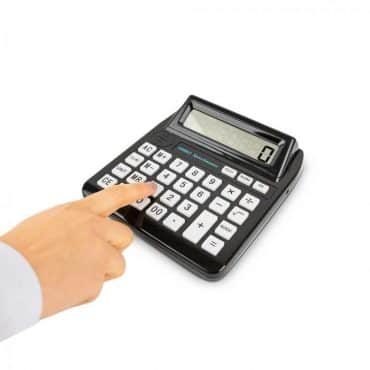
According to the Healthline website, the average daily calorie intake for men is 2,300-2,500 kcal per day and about 2,000 kcal per day for women. Therefore, our bodies’ energy is spent constantly, and it doesn’t matter if you perform some heavy physical activity or not.
Therefore, it is very important to ensure that the daily calorie intake is selected correctly to replenish energy and maintain the body tone. The food storage calculator can help you with this tricky task so that you would be able to calculate the necessary food supply for the whole family in the most accurate way.
Survival Food Storage
Preparing to store food and other cooking essentials for emergencies requires you to know what foods are safe for storage for years to come. If a disaster strikes and you cannot resupply with fresh food, you want to find a food reserve in good condition.
Such food must retain its quality, taste, and nutritional value. Hence, you need to know which foods and cooking essentials to get and how to store them properly to extend the shelf life.

We highly recommend you purchase several emergency food kits that last 72 hours. Such a set contains freeze-dried foods that are already cooked. You only need to fill them with water. Augason Farm’s 72 Hour Emergency Kit is perfect not only for natural disasters prep or in the event of a prolonged power outage but also for hiking to make the rest comfortable and full.
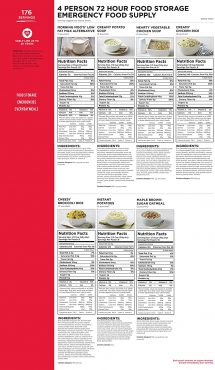
In general, freeze-dried meals are ideal for long-term storage. Freeze-drying eliminates the need for refrigerated storage since dry products can be stored for a long time at positive temperatures.
Here are a few more benefits of preparing food this way:
- the total weight of products after freeze-drying is significantly decreased. Therefore, it simplifies the handling and transportation
- the original taste almost does not change
- simplified storage system and extended shelf life
- the nutritional value and other important indicators of the products are preserved
This method of conservation will allow you to preserve meat, fish, dairy, and egg products, as well as vegetables and fruits from your garden, for a long time, almost without changing their initial properties.
Containers for Long-Term Food Storage
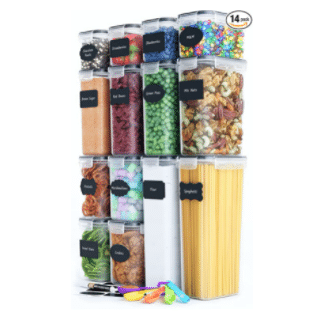
If you still do not have a single container at home, you should think about such a useful investment of money. There are a lot of different options for every taste and color available on the Internet today. You just need to choose any container for long-term storage you like and order it.
The material of the containers can be different. For example, if you are not going to store food for months, there are more plain containers for short food storage. They differ little from the previous ones, except in the tightness and security level.
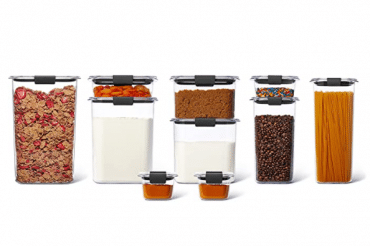
Minimum Food Storage Amounts
According to the World Health Organization research, the average number of calories per day for adults is around 2,100-2,300. Along with this, for people of different ages, this value is different.
It is always worth remembering the individual characteristics of family members. For example, be sure to take into account their individual need for calories, the level of their expenditure depending on the intensity and frequency of physical activity, and the body’s response to certain foods in the diet.
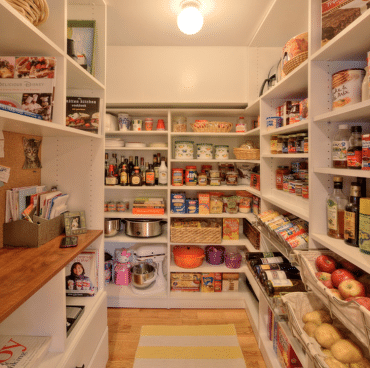
Calories
Below is a list of the average values of the required calorie intake per day for different age groups (values may vary due to personal characteristics):
Age group 2-5 years — 1,200-1,600 calories per day
Age group 6-8 years — 1,400-1,800 calories per day
Age group 9-10 years — 1,600-2,000 calories per day
Age group 11-12 years — 1,800-2,200 calories per day
Age group 13+ years and adults — 2,000-2,400 calories per day
Active females — 2,200-2,400 calories per day
Active males — 2,600-3,000 calories per day
Food storage amounts
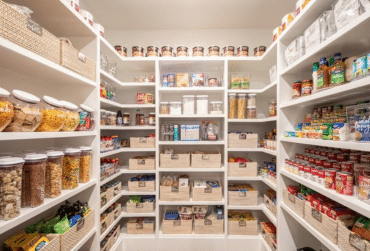
Below you will find the average amount of food you need to store and eat per month and per year (per month/per year respectively) divided into certain groups:
- Water — 16-20 gallons/180-200 gallons
- Canned fruit and vegetables — 27-30 lbs/320 lbs
- Dried fruit and vegetables — 8-10 lbs/90 lbs
- Grains (Wheat, pasta, white rice, oats, flour, etc.) — 32 lbs/390 lbs
- Beans (Dried beans, soybeans, lima beans, split peas, dry soup mix) — 5.8-6 lbs/70 lbs
- Canned or dried meats (Beef, fish, chicken, jerky, etc.) — 1.6-2 lbs/20 lbs
- Dairy products (Powdered milk, dried milk, evaporated milk, etc.) — 7.25-7.5 lbs/87 lbs
- Fats and oils (Vegetable oils, peanut butter, butter, etc.) — 2 lbs/25 lbs
- Sugars (White sugar, brown sugar, honey, powdered fruit drink) — 5 lbs/60 lbs – Learn how to make sugar at home.
- Cooking essentials (Table salt, leavening agents, baking powder, yeast, soy sauce) — 0.7-1 lbs/8 lbs
This is the average food recommendation for one adult per month. The food storage calculator will help you create a meal preparation plan individually for your family, just enter the required information.
Water
According to experts, on average, about 1.5-2 liters (or half a gallon) of fluid are needed for a person per day. Of course, it does not have to be only pure drinking water, but it is better to be the basis of this amount.
What is Food Storage Calculator?
A food storage calculator is a special device or handwritten storage manual designed to accurately calculate the amount of food needed for a family or one person for months or years of storage.
To use the food storage calculator, you need to enter information about you and your family, including food preferences and estimated shelf life. Then, the calculator estimates the required food storage amounts from the input data and provides you a ready-made list of foods.
Do not forget that you need to store only food with a sufficient shelf life to allow you to do so. Also, it is best to obtain basic ingredients. It includes wheat, split peas, dried beans, grains, sugars, salt, and other foods rich in fats and oils. So, by combining these simple ingredients, you will have a complete, fresh meal.
This will help you maintain a healthy and habitual diet, even in the most urgent cases.
Food Storage Calculator Guide

So, a more detailed step-by-step instruction:
- Identify your family members’ favorite foods, meals, and selected products.
- Write down a detailed recipe of each survival meal and the number of ingredients, and then multiply by 12 (this way, you will calculate the number of ingredients needed to prepare a certain dish once a month throughout the year).
- Replenish the utility room with the received amount of products and repeat the same for other dishes from your usual menu.
NOTE:
- Please remember to check the shelf life of stored food from time to time. Then, start consuming those foods that you purchased earlier than others. This smart food storage method is called “First in, first-out” (FIFO) and is useful for safe and wise consumption.
Best way to organize food storage

Put newly purchased products behind older ones, so the “first-in, first-out” products will always be at hand without any confusion.
You can find many of these organizers and rotators in online shops. The most popular is the food storage organizer from DecoBros Stackable Can Rack. It is a very useful investment because it has dividers of different sizes, so you would not be bothered looking for canned foods of the same size.
Tips for Long-Term Food Storage
Here are some useful and life-saving tips on how to store food without consequences:
- In a prolonged power outage, it is recommended to eat the stored food from the refrigerator first, as food stored in the refrigerator after a power outage will only be edible for two days. Then, you should empty the freezer. Storage food supply should come last. Fridge and freezer doors need to be locked tight (Federal Emergency Management Agency, FEMA).
- Don’t let the temperature of your refrigerator rise above 40 ° F. It is best to get a reliable generator in advance that would keep it running consistently.
- If the packaging of canned goods is fractured or swollen, in no case should you eat the contents. The same applies to the expiration date (The Red Cross, ARC).
- Store canned foods and other similar products in airtight containers in cool, dry, and dark places with temperatures up to 60 ° F (Centers for Disease Control and Prevention, CDC).
- Constantly check the expiration date of stored food and water, and replace them with fresh ones every six months or a year. There is nothing worse than poisoning with non-benign products in survival conditions (some can be treated with activated charcoal, though), and in general, too, of course.
You can find other helpful tips for efficient food storage on the NFP website (National Center for Home Food Preservation).
Food storage is not that complicated. The main thing is to learn how to do it best!
Final Thoughts
In this article, we tried to collect as much comprehensive information as possible on how much food storage you need and the advantages of using a food storage calculator. This appliance is good not only as a functional kitchen accessory but is also irreplaceable when it comes to strategic food storage for you and your family members.
Don’t forget to keep track of the products in your food storage. Take into account the costs of certain products and record the dates of their purchases and expiration dates. This will identify overrun items and help you stick to the “first in, first out” method. What is more, you will see when the expiration date of a particular product will come to an end. Good luck with the tricky but interesting food storage planning!
Frequently Asked Questions (FAQ)
How do you calculate food storage?
It is quite challenging to find out how much water and food needs to be reserved in emergencies or any other case. Every person has their own necessity for total fats, sugars, and calories, according to their gender, age, and overall activity level.
It is also essential to consider that the weather is also an important factor for food storage calculations. You can find a detailed plan on how to use a food storage calculator in the article above.
How much food does a family of 4 need for 6 months?
It depends on the age, gender, and other personal characteristics of every family member. But regardless of these individual features, almost everyone in your family needs essential products such as salt, white or brown sugar, powdered milk, baking powder, wheat, and grains.
In our article on family grocery storage planning, we detailed how much fats, sugars, water, and other food should be prepared for each family member, as well as the specified period. So please go back to the part with the calculation table and read it carefully. Then you and your family can start using the food storage calculator!
How much food would you need for a year?
It depends on how many family members you have and what age they are. However, there are many things you need to consider before starting the food storage creation process.
There is one general rule for food storage: there should be only those comfort foods that are suitable for your family. Never stockpile products your family is not used to, even if it is very healthy and nutritional. Survival is not a suitable experience for arranging cooking experiments on your family.
For more information, re-read the article above.
How much food should you stockpile?
Try to stock up on as many long-lasting foods as possible, especially when you don’t know the exact period the food storage may take. Also, do not forget about the proportion of proteins, fats, and carbohydrates consumption.
We advise you to purchase products such as:
- Grains (Wheat, flour, pasta, rice, oats, etc.)
- Beans (Lima beans, split peas, dried beans, dry soup mix, soybeans, etc.)
- Sugars (white or brown sugar, chocolate, peanut butter, corn or maple syrup, etc.)
- Cooking Ingredients (Table salt, baking powder, powdered fruit drink, evaporated milk, powdered milk, etc.)
- Freeze-dried foods


